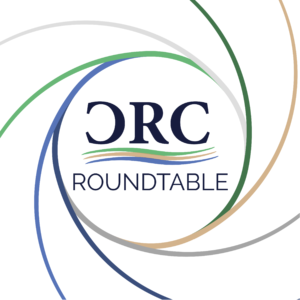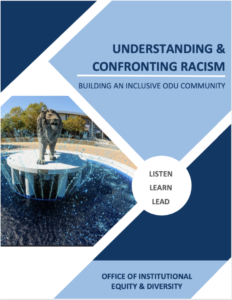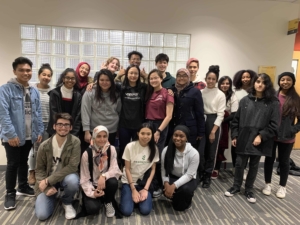Taking Action for Diversity, Equity, Inclusion, and Justice
2020 has brought unprecedented change to our world, including the global COVID-19 pandemic, protests against systemic racism, and welcomed discussions about ensuring that diversity, equity, inclusion, and justice (DEIJ) goals are actualized and institutionalized. One of the many benefits of the Chesapeake Research Consortium (CRC) umbrella of seven research institutions is that our members can share resources, lessons, and dialogue on topics like this one, where everyone is interested in how they can do better.
 Before we dive into more Chesapeake Bay-focused information, we acknowledge that conversations around DEIJ are taking place on a global scale and there is a wealth of information available from outside of our region. For example, the journal Nature recently published an article on increasing “Diversity in science: next steps for research group leaders” in their online Career Guide. The article provides some stark realities: “In the United States, for instance, 13% of the population is Black, but Black researchers comprise just 6% of faculty positions in science, technology, engineering and mathematics (STEM). According to the Pew Research Center in Washington, D.C., 62% of Black STEM employees in the United States say they have experienced racial or ethnic discrimination at work, and 57% say their workplaces do not pay enough attention to racial and ethnic diversity.” The article uses data from the US, UK, and Brazil to detail the lack of diversity, equity, and inclusion in academia from the admissions process through institutional leadership roles.
Before we dive into more Chesapeake Bay-focused information, we acknowledge that conversations around DEIJ are taking place on a global scale and there is a wealth of information available from outside of our region. For example, the journal Nature recently published an article on increasing “Diversity in science: next steps for research group leaders” in their online Career Guide. The article provides some stark realities: “In the United States, for instance, 13% of the population is Black, but Black researchers comprise just 6% of faculty positions in science, technology, engineering and mathematics (STEM). According to the Pew Research Center in Washington, D.C., 62% of Black STEM employees in the United States say they have experienced racial or ethnic discrimination at work, and 57% say their workplaces do not pay enough attention to racial and ethnic diversity.” The article uses data from the US, UK, and Brazil to detail the lack of diversity, equity, and inclusion in academia from the admissions process through institutional leadership roles.
We spoke with representatives across our membership to gain a broader perspective of what actions related to DEIJ are taking place across institutions and communities. What we found is that members are embracing a variety of approaches, including holding thought-provoking webinars, creating task forces and inclusion councils, and providing resource guides for students and faculty who want to combat racism and create a more inclusive community. Restrictions on social gatherings have not kept member institutions from having these important conversations, but instead have presented an opportunity for more creative ways to hold a dialogue.
What’s Happening at Member Institutions
Hosting virtual conversations
 At CRC, we recently held a lunchtime webinar on Integrating Environmental Justice into Decision-Making as part of our CRC Roundtable series. In addition to the Roundtable, we also invite open and honest conversation around DEIJ on our CRC LinkedIn page. We have also devoted our upcoming November Roundtable webinar to dig in deeper on understanding what Environmental Justice is, what it looks like, and what data and tools are needed to support it. CRC’s Executive Director, Denice Wardrop, goes into more detail on ways we are paying attention and taking action in her Director’s Corner.
At CRC, we recently held a lunchtime webinar on Integrating Environmental Justice into Decision-Making as part of our CRC Roundtable series. In addition to the Roundtable, we also invite open and honest conversation around DEIJ on our CRC LinkedIn page. We have also devoted our upcoming November Roundtable webinar to dig in deeper on understanding what Environmental Justice is, what it looks like, and what data and tools are needed to support it. CRC’s Executive Director, Denice Wardrop, goes into more detail on ways we are paying attention and taking action in her Director’s Corner.
Penn State University (PSU), one of our member institutions, hosted a series of three webinars starting at the end of June to promote communication and dialogue within the campus community about issues involving race. The first two webinars titled, “Race, Our Campus Climate and Workplace,” and “What will be the new normal? A conversation with Penn State students, faculty and staff of color” discussed the experiences of people of color at a university with a majority white campus and aimed to discover ways to advance equity and inclusion for students, faculty, and staff of color. The series will culminate on November 5th with the third and final webinar, titled “Race in the Community.”
 “At this moment, when so many across the globe are frustrated and speaking out against systemic racism, we want to provide an opportunity for our community to come together, listen and learn together,” Marcus Whitehurst, vice for provost for Educational Equity, said. “This is an opportunity to learn more about the challenges and lived experiences of friends and colleagues of color, and to walk away with greater understanding of how each of us can support diversity, equity and inclusion in our communities, at our University and in our nation.”
“At this moment, when so many across the globe are frustrated and speaking out against systemic racism, we want to provide an opportunity for our community to come together, listen and learn together,” Marcus Whitehurst, vice for provost for Educational Equity, said. “This is an opportunity to learn more about the challenges and lived experiences of friends and colleagues of color, and to walk away with greater understanding of how each of us can support diversity, equity and inclusion in our communities, at our University and in our nation.”
Task forces in action
Johns Hopkins University (JHU) is reassessing programs and activities as part of its Roadmap on Diversity and Inclusion, launched five years ago. The Roadmap 2020 Task Force was announced in July along with several other initiatives and will lead the process of reviewing the previous Roadmap and developing a set of new recommendations for the upcoming five years.
The task force includes not only students, faculty, and staff, but also members of the Baltimore community. “For the task force to succeed, it must draw upon the perspectives and experiences of a wide-ranging representation of stakeholders from across our institution, including faculty, staff, and students, as well as the broader Baltimore community,” said JHU President Ronald J. Daniels and Provost Sunil Kumar in their message to the university community. “We were fortunate to have had significant interest from many people at all levels of our institution.”
 Old Dominion University (ODU) has a number of diversity, equity, and inclusion initiatives in place, including the President’s Task Force for Inclusive Excellence, a commUNITY conversation series, and recently released a resource guide, complete with discussion protocols and study guides, for the campus community. The guide contains articles, books, podcasts, videos, and programs about a range of topics addressing different facets and dimensions of structural racism and inequities and will be updated as new content becomes available.
Old Dominion University (ODU) has a number of diversity, equity, and inclusion initiatives in place, including the President’s Task Force for Inclusive Excellence, a commUNITY conversation series, and recently released a resource guide, complete with discussion protocols and study guides, for the campus community. The guide contains articles, books, podcasts, videos, and programs about a range of topics addressing different facets and dimensions of structural racism and inequities and will be updated as new content becomes available.
The University of Maryland, Baltimore County (UMBC) created an Inclusion Council consisting of students, faculty, staff, and alumni working with the campus community in late June to address systemic racism on campus.
Student activism on campus

A pre-pandemic photo of UMBC Greenpeace from the fall of 2019
On university campuses, student activities and interaction also look a little different than they used to. As the president of the UMBC Greenpeace club, college junior Aiman Raza, shared how they are running a club during a fully virtual semester, from holding virtual events to trying to be more active on social media. In a normal semester, clubs would typically hold tabling events, where they set up a table with information and ask students to sign petitions. This year, however, UMBC Greenpeace held a virtual tabling event, where they picked a few charities and petitions to promote and sent out links to sign or donate in an email.
Inspired by her time as a C-StREAM fellow, Aiman suggested environmental justice (EJ) as an important topic for UMBC Greenpeace to raise awareness about this year. The club has held two virtual guest speaker events focusing on EJ this semester, featuring Carmera Thomas, the Baltimore Program Manager of the Chesapeake Bay Foundation, and Curtis Bennett, the Director of Equity and Community Engagement at the National Aquarium.
Raza thinks that the pandemic has also changed the way the club will pick topics to focus on in the future. Previously, the club focused on larger, more national issues, like fracking, but now they are shifting focus to the community around them and the human dimension. ”Learning about environmental justice, it’s hard to do that without talking about social justice. After learning about all of the local issues in Baltimore, we’re definitely more interested in focusing on the social aspect of issues.”
DEIJ Activities in the Watershed
Earlier this year, the Diversity Workgroup of the Chesapeake Bay Program finalized a Diversity, Equity, Inclusion and Justice (DEIJ) strategy with the goal to grow racial and ethnic diversity within the partnership from 13% to 25% (including 15% of leadership), help partners develop as DEIJ leaders who understand, respect and embrace cultural diversity, and provide them with the tools to continually assess progress towards diversity goals. At the August 2020 Executive Council meeting, members signed an action statement in support of this strategy, recognizing the efforts of each partner to integrate DEIJ into their programs and policies and committing to do more to ensure that DEIJ is integrated throughout the entire partnership. At their July 2020 meeting, the Principals’ Staff Committee (PSC) signed their own action statement, which detailed several tangible steps to be taken to ensure these DEIJ goals are met. The actions contained within the PSC DEIJ action statement are in varying degrees of progress, but most notably to mention is the creation of a DEIJ implementation plan for the DEIJ Strategy, which will include outreach to underrepresented communities for input and feedback, and the formation of Community Advisory Board composed of environmental justice leaders and representatives from organizations led by people of color or underrepresented groups.
Additionally, in May 2019 the Chesapeake Bay Trust, Choose Clean Water Coalition, and Chesapeake Bay Funders Network shared their summary report: “DEIJ in Action: A Diversity, Equity, Inclusion, and Justice Guide for the Chesapeake Bay Watershed.” This report provides a path forward for organizations on advancing DEIJ goals. This report is a valuable resource for any organization developing a DEIJ action plan.
Here at CRC, we are looking forward to listening, learning, and working together to create lasting change. We know that, collectively, we have a long way to go to truly achieve DEIJ goals and that the actions and steps taken by CRC member institutions in this article are just the beginning. The tumultuous year of 2020 has been challenging but one of the silver linings is the progress being made on making environmental efforts through academia and other institutions more diverse, equitable, and inclusive. As we mentioned above, we’ve devoted our October and November Roundtable webinars to digging in deeper on understanding what Environmental Justice is, what it looks like, and what data and tools are needed to support it. If you missed our October Roundtable, you can watch it online. To join our November Roundtable, please register on our website. To further action and conversation, we are sharing some of the resources we have collected on EJ.
Environmental Justice Resources
- Pennsylvania – Environmental Justice Areas
- New York – Potential Environmental Justice Areas
- Maryland EJSCREEN
- Virginia DEQ – Environmental Justice
- Chesapeake Bay Environmental Justice and Equity Dashboard
- It leverages a variety of spatial data layers, including layers from EPA EJSCREEN, EnviroAtlas, Social Vulnerability Index, and other data.
- A regional DEIJ Guidebook developed for Chesapeake Bay Foundation, Choose Clean Water Coalition, and the Chesapeake Bay Funders Network
- The Ecological Society of America – Resources For Diversity, Equity, Inclusion, and Justice (DEIJ)
- Two counties on Maryland’s Lower Eastern Shore, where there are hundreds of concentrated animal feeding operations (CAFOs), have unhealthy levels of nitrate in drinking water, which may lead to health problems such as blue baby syndrome, thyroid disease and pregnancy complications.
